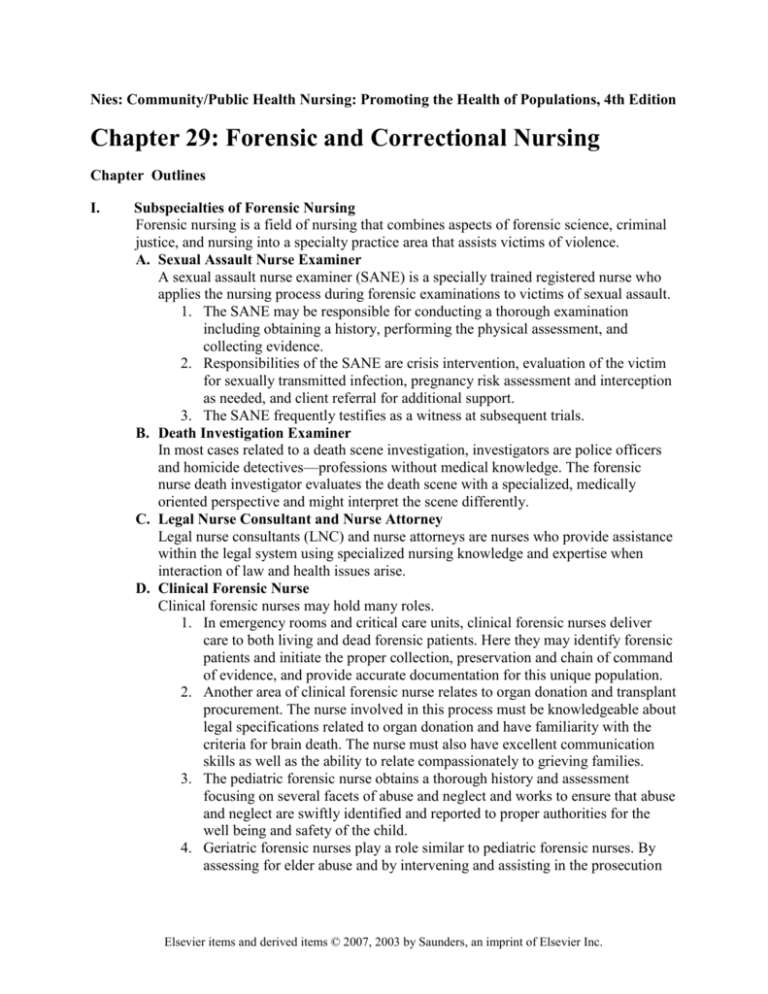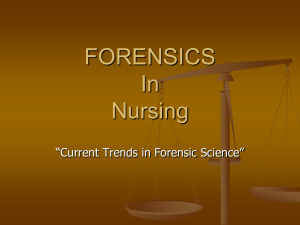
Nies: Community/Public Health Nursing: Promoting the Health of Populations, 4th Edition
Chapter 29: Forensic and Correctional Nursing
Chapter Outlines
I.
Subspecialties of Forensic Nursing
Forensic nursing is a field of nursing that combines aspects of forensic science, criminal
justice, and nursing into a specialty practice area that assists victims of violence.
A. Sexual Assault Nurse Examiner
A sexual assault nurse examiner (SANE) is a specially trained registered nurse who
applies the nursing process during forensic examinations to victims of sexual assault.
1. The SANE may be responsible for conducting a thorough examination
including obtaining a history, performing the physical assessment, and
collecting evidence.
2. Responsibilities of the SANE are crisis intervention, evaluation of the victim
for sexually transmitted infection, pregnancy risk assessment and interception
as needed, and client referral for additional support.
3. The SANE frequently testifies as a witness at subsequent trials.
B. Death Investigation Examiner
In most cases related to a death scene investigation, investigators are police officers
and homicide detectives—professions without medical knowledge. The forensic
nurse death investigator evaluates the death scene with a specialized, medically
oriented perspective and might interpret the scene differently.
C. Legal Nurse Consultant and Nurse Attorney
Legal nurse consultants (LNC) and nurse attorneys are nurses who provide assistance
within the legal system using specialized nursing knowledge and expertise when
interaction of law and health issues arise.
D. Clinical Forensic Nurse
Clinical forensic nurses may hold many roles.
1. In emergency rooms and critical care units, clinical forensic nurses deliver
care to both living and dead forensic patients. Here they may identify forensic
patients and initiate the proper collection, preservation and chain of command
of evidence, and provide accurate documentation for this unique population.
2. Another area of clinical forensic nurse relates to organ donation and transplant
procurement. The nurse involved in this process must be knowledgeable about
legal specifications related to organ donation and have familiarity with the
criteria for brain death. The nurse must also have excellent communication
skills as well as the ability to relate compassionately to grieving families.
3. The pediatric forensic nurse obtains a thorough history and assessment
focusing on several facets of abuse and neglect and works to ensure that abuse
and neglect are swiftly identified and reported to proper authorities for the
well being and safety of the child.
4. Geriatric forensic nurses play a role similar to pediatric forensic nurses. By
assessing for elder abuse and by intervening and assisting in the prosecution
Elsevier items and derived items © 2007, 2003 by Saunders, an imprint of Elsevier Inc.
Lecture Outlines
II.
III.
IV.
28-2
of instances of elder abuse, the forensic nurse promotes well-being and safety
of vulnerable elders.
E. Forensic Psychiatric Nurse
The forensic psychiatric nurse bridges the gap between the criminal justice, legal and
mental health systems. Roles or activities provided by psychiatric forensic nurses
include sanity or competency evaluation for legal purposes, assessment of violence
potential, assessment of capacity to formulate intent, parole/probation considerations,
assessment of racial/cultural factors in crime, assistance in jury selection, sexual
predator screening, and provision of expert witness testimony.
Correctional Nursing
In correctional nursing, care is negotiated and provided with recognition of safety and
security issues for the nurse and the constitutional right of prisoners to receive adequate
and timely health care. The primary goals in correctional facilities are security and a safe
and humane environment for inmates.
A. Prison Culture
Understanding the prison culture is essential to nursing practice in correctional
settings. Where people are incarcerated, often for significant periods of time, a
distinct way of life evolves.
1. Prison culture has its own rules, language, and traditions that is not
understandable to the outside world.
2. Prison gangs are often associated with and held liable for prison violence. For
many inmates, prison gangs are a source of protection, which is consistent
with the notion that being alone and surviving in a correctional facility is
difficult.
Health Issues in Prison Populations
Inmates often enter prison having significant health problems. Most health care clinics in
correctional environments screen each inmate upon entry into the facility. The health care
triage process generally includes a physical health history and a mental health history.
Many significant health care issues are recognized during the screening process, often for
the first time.
A. Chronic and Communicable Diseases
The most critical heath care issues among the incarcerated population are chronic and
communicable diseases. Communicable diseases that are common in prison
populations include:
1. HIV.
2. Hepatitis.
3. Tuberculosis.
Women in Prison
Women who are incarcerated have special needs related to roles and reproductive
function.
A. Almost two thirds of women in prison have at least one child under the age of 18
years.
B. Recommendations are that special consideration be given to the reproductive health
needs of women, high rate of victimization among incarcerated women, counseling
related to parenting issues, and accessibility to drug or alcohol treatment.
Elsevier items and derived items © 2007, 2003 by Saunders, an imprint of Elsevier Inc.
Lecture Outlines
V.
VI.
VII.
28-3
Adolescents in Prison
A particular concern for incarcerated adolescents is related to incarceration in adult
facilities.
A. Adolescents experience unique developmental changes that include rapid physical
and emotional growth and unique nutritional needs, all influenced by environment,
genetics, and family experiences. Adult correctional facilities are not generally
equipped to deal with the challenges of adolescent development.
B. Adolescents in an adult correctional facility are more likely to be sexually assaulted,
attacked by other inmates, or threaten suicide than adolescents in a juvenile facility.
Juveniles in detention and correctional facilities are 4 times more likely than youths
in the general public to commit suicide, and 50% to 75% have diagnosed mental
illness.
C. To ensure the safety of adolescents in an adult facility, the nurse must be aware of
their individual vulnerability. A mechanism for adolescents to access medical and
mental health care is essential. The services provided must also be in the context of
the developmental stage and experience of adolescence.
Mental Health Issues in Correctional Settings
People with mental illness are often jailed for crimes committed in response to the
symptoms of mental illness. With community services declining and increasing numbers
of people with mental illness being incarcerated, the “criminalization of the mentally ill”
has become a reality. The constitution provides a right to mental health care for prisoners.
A. The following strategies have been suggested to reduce the number of incarcerated
people with severe mental illness:
1. Diverting nonviolent offenders with severe mental illness away from
incarceration to adequate treatment.
2. Convening mental health courts to address all cases involving offenders with
severe mental illness.
3. Training court judges and personnel about severe mental illness.
B. Nurses employed in correctional settings must always be aware of the vulnerabilities
of people with mental illness who are incarcerated. Depression, schizophrenia,
bipolar disorder, and other NBDs can be readily treated with new-generation
psychiatric medications that radically reduce or ameliorate symptoms, but the unique
vulnerabilities of incarceration often remain.
C. Access to mental health treatment, including psychiatric medication, is a
constitutional right for prison inmates. Correctional facilities must supply inmates
with psychotropic medication after discharge for a time reasonable to seek
community mental health treatment. Consequently, the state’s responsibility for
providing psychiatric medication extends beyond discharge from a correctional
facility into the community.
Standards of Nursing Practice in Correctional Settings
Several accrediting bodies have issued standards of nursing practice applicable to
correctional settings. Guidelines articulate standards of practice for specific populations
and health care issues, including communicable diseases, health care service delivery
systems, and standards of practice for vulnerable population such as women, adolescents,
and people with mental illness.
Elsevier items and derived items © 2007, 2003 by Saunders, an imprint of Elsevier Inc.
Lecture Outlines
28-4
A. The American Nurses Association Nursing Practice Standards and Guideline for
Corrections Nursing generally address the use of the nursing process in the
correctional setting.
B. The American Correctional Association and National Commission have written
guidelines for nursing practice in correctional health care.
VIII. Education and Forensic Nursing
Forensic nurses require in depth knowledge and skills acquired through specialized
programs of study. Colleges and universities have begun to offer these specialized
programs to educate forensic practitioners. In addition to forensic nursing fundamentals
such as evidence collection, documentation, and testifying, subjects include forensic law
and forensic science. Supervised clinical hours or a clinical internship may also be
required.
Elsevier items and derived items © 2007, 2003 by Saunders, an imprint of Elsevier Inc.








